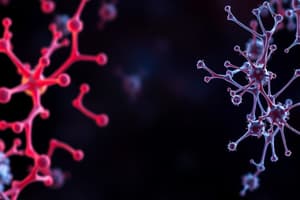Podcast
Questions and Answers
Differentiate between innate immunity and adaptive immunity.
Differentiate between innate immunity and adaptive immunity.
Innate immunity is the immunity you are born with and serves as the first and second line of defense, while adaptive immunity develops over time and becomes more effective with each exposure to a pathogen.
What is included in the first line of defense of innate immunity?
What is included in the first line of defense of innate immunity?
- Phagocytes
- Normal microbiota (correct)
- Intact skin (correct)
- Mucous membrane (correct)
What are components of the second line of defense in innate immunity?
What are components of the second line of defense in innate immunity?
- Phagocytes (correct)
- Fever (correct)
- Specialized lymphocytes
- Inflammation (correct)
What specialized cells are part of the third line of defense in adaptive immunity?
What specialized cells are part of the third line of defense in adaptive immunity?
What is phagocytosis?
What is phagocytosis?
Describe the process of inflammation.
Describe the process of inflammation.
What is the role of fever in the immune response?
What is the role of fever in the immune response?
What is the complement system?
What is the complement system?
What do interferons do?
What do interferons do?
Flashcards are hidden until you start studying
Study Notes
Innate Immunity vs. Adaptive Immunity
- Innate immunity is the natural defense system present at birth, acting as the first and second line of defense.
- It isolates infections to allow adaptive immunity to take control.
- Adaptive immunity develops over time and takes 7-14 days to respond unless memory cells from past infections are present.
- Exposure to pathogens enhances adaptive immunity, allowing for quicker responses upon re-exposure.
Innate Immunity: First Line of Defense
- Intact skin acts as a physical barrier to pathogen entry.
- Mucous membranes trap pathogens and help prevent infections.
- Normal microbiota compete with pathogens for resources, providing additional protection.
Innate Immunity: Second Line of Defense
- Phagocytes, including neutrophils, eosinophils, dendritic cells, and macrophages, play a crucial role in identifying and destroying invaders.
- Inflammation is triggered in response to pathogens, increasing blood flow to the area.
- Fever is a systemic response that can enhance immune function and inhibit pathogen growth.
- Antimicrobial substances are released to combat infections.
Adaptive Immunity: Third Line of Defense
- Specialized lymphocytes, such as T-cells and B-cells, are central to the adaptive immune response.
- Antibodies produced by B-cells target specific pathogens for destruction.
Phagocytosis Process
- Neutrophils are the first responders during an infection; they ingest pathogens through phagocytosis.
- Toll-like receptors (TLRs) on phagocytes identify pathogen-associated molecular patterns (PAMPs).
- The phagocyte engulfs the microbe, forming a phagosome that fuses with a lysosome to create a phagolysosome.
- The contents are digested, and indigestible materials form residual bodies that are expelled from the cell.
Inflammation Response
- Introduced bacteria from wounds trigger tissue chemical release, promoting vasodilation and increased blood vessel permeability.
- Platelets form clots to isolate infection, while white blood cells migrate to the infection site via chemotaxis.
- Phagocytes squeeze through endothelial cells to perform phagocytosis at the site.
Tissue Repair Mechanism
- Tissue repair occurs during the active phase of inflammation, replacing dead and damaged cells.
- Repair can only proceed after all harmful microbes are neutralized.
Fever Induction
- The hypothalamus sets the body's temperature at 37°C; bacterial endotoxins stimulate phagocytes to release interleukin-1.
- This triggers the hypothalamus to elevate the body's "thermostat," causing fever.
- The body responds with vasoconstriction, increased metabolism, and shivering to raise temperature until cytokines are eliminated.
The Complement System
- Comprises over 30 proteins that enhance immune responses, produced by the liver and found in serum.
- Activated C3 protein initiates a cascade leading to cytolysis, inflammation, and enhanced phagocytosis.
- C3b binds to microbes, enhancing phagocytosis by coating them.
- The complement cascade culminates in the formation of a membrane attack complex, leading to microbial lysis.
Interferons Function
- Interferons are critical for anti-viral defense by preventing virus replication.
- When a virus infects a host cell, it triggers the production of interferons that are released to signal nearby cells, enhancing their viral resistance.
Studying That Suits You
Use AI to generate personalized quizzes and flashcards to suit your learning preferences.




